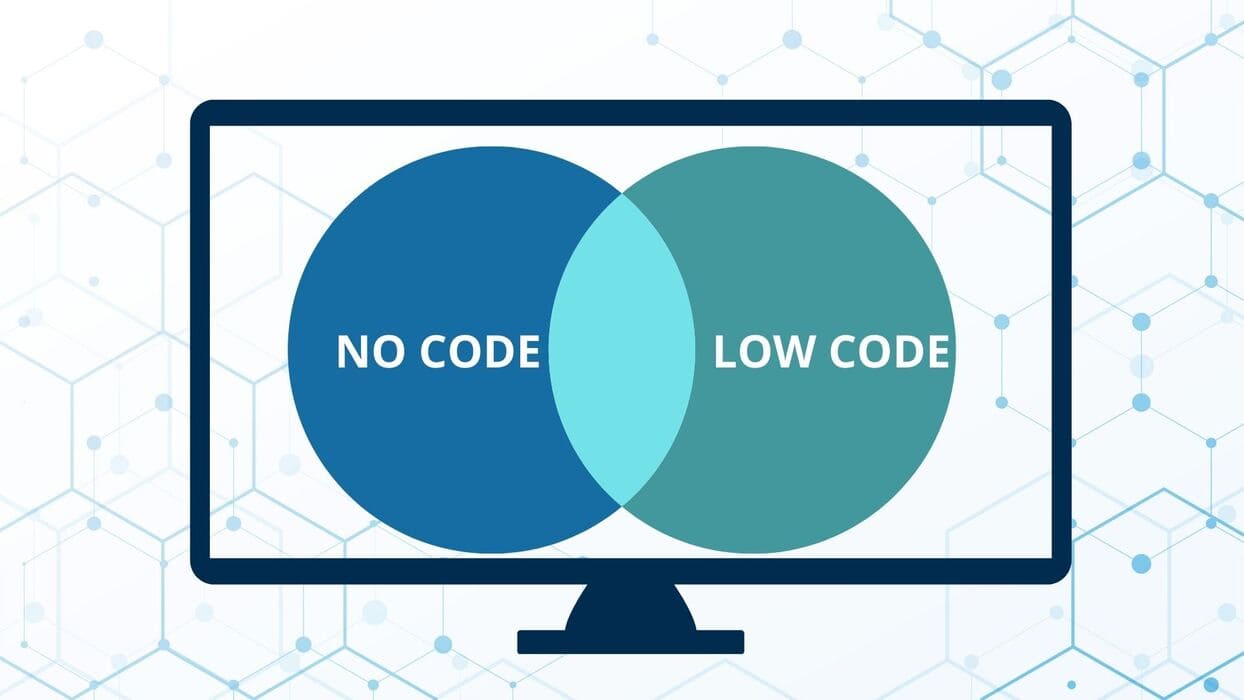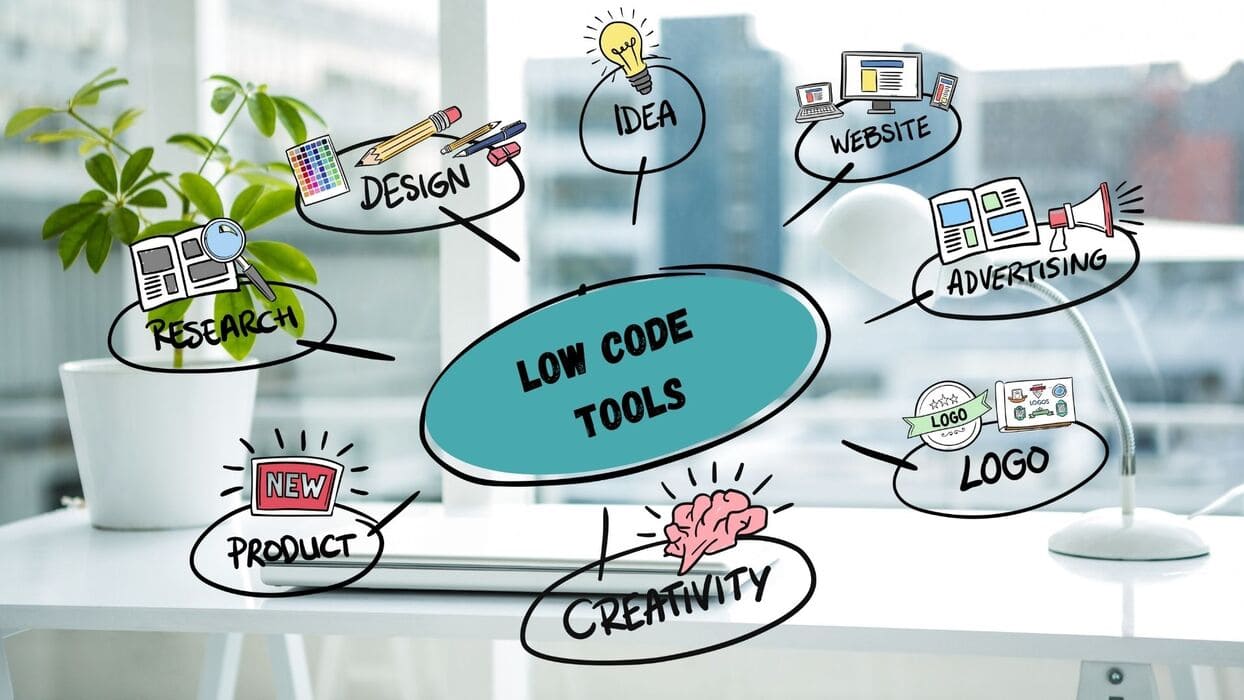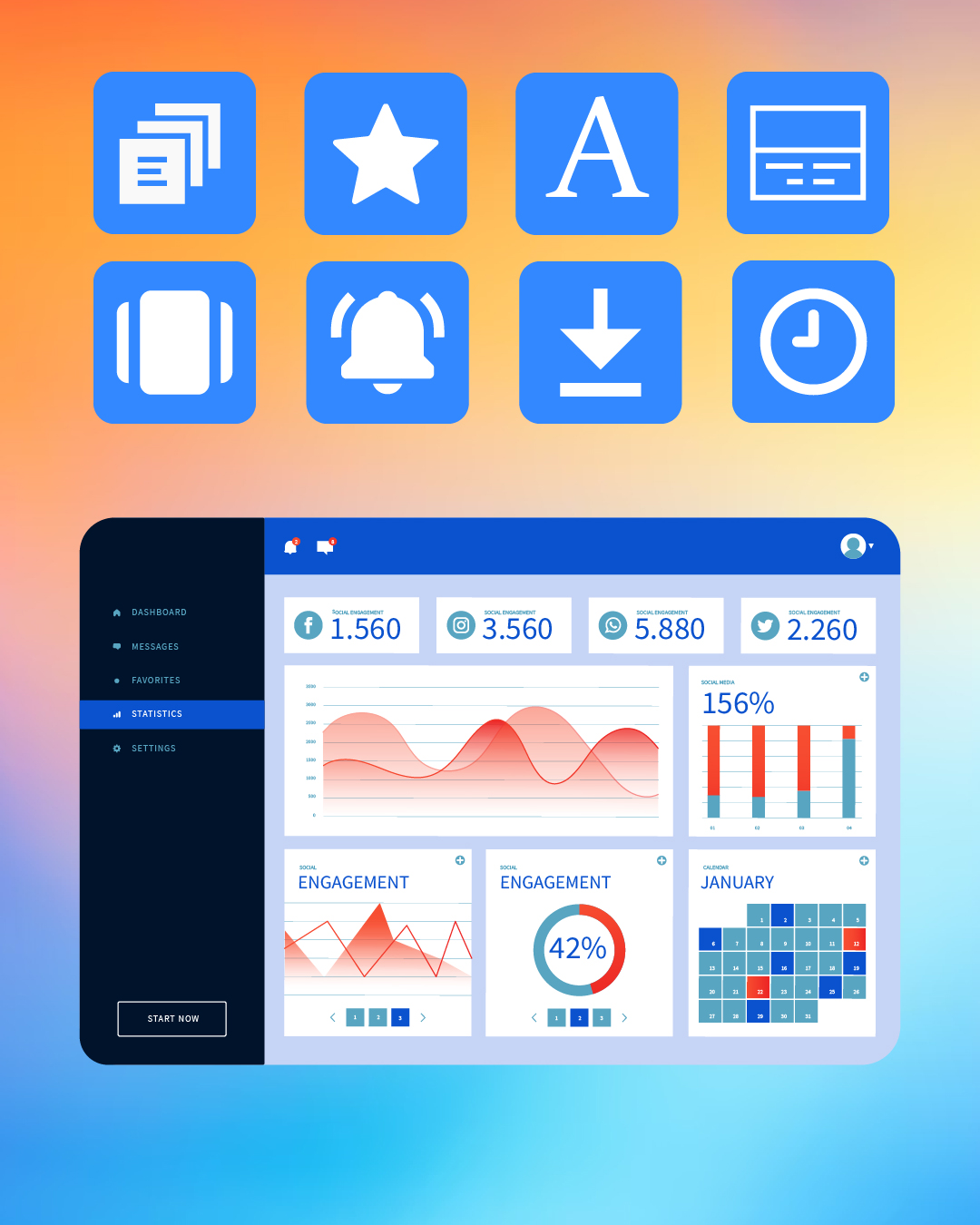Low Code Development
A Complete Guide
What is low-code?
Low code is a web development technology that allows users to build, design and launch web applications without heavy coding. Moreover, it aims to reduce the tiring process of traditional web development. Thus, all low code platforms create a low coding environment to build responsive web applications using different low code tools. Also, as they involve very little coding than traditional hand-coding, your application gets ready to launch faster.
Moreover, low code platforms are especially designed with a graphical user interface. It gives visual experience of building web apps and makes it more fun. The visual user-interface that requires no to low coding speeds up the production and delivery process. Furthermore, breaks up the tiring cycle of traditional web and software development. Also, other features like automated workflows, web development toolkit, reusable components, etc. empower developers and improve their overall productivity.
Low Code App Development - Features
Below are some basic features of a low code platform:
Visual IDE Experience
Low code platforms create an integrated development environment (IDE). It blends web development tools into a graphical user interface to visually build and design low code applications usingWYSIWYG approach. Also, it doesn’t require heavy coding to build apps like in traditional web development. Therefore, allows non-tech users to build web apps faster and easier while having fun.
Drag-and-drop Interfaces
Drag-and-drop UI is the core feature of low code/no code technology. It is what makes building web applications on low code web app builders so convenient and easy. Moreover, it allows citizen developers or non-tech developers to easily build any type of application without much coding or programming. Therefore, the drag-and-drop interface is a must-have feature in all the low code app building platforms.
Reusable Components
The foundational idea to invent low code development is to cut down the time that traditional web development takes. Therefore, low code platforms are infused with pre-built sections, templates and pre-configured components to build and design web apps faster. Also, these components speed up the web development process as they can be re-used again and again. Besides pre-built sections and pre-configured components, there are several integrations and plugins to add multiple functionalities with less coding.
Scalability & Testability
The whole framework of low code technology is constructed in a very flexible manner. Therefore, all web applications built on low code web development platforms are highly scalable. Therefore, with the growth of your business, you can easily scale up your web application as well. Before launching a newly built web application, testing it for smooth operations is very important. Therefore, all low code platforms provide a smooth testability ground to test your web applications under all requirements and circumstances without any issue before launching them.
Multi-platform Accessibility
As there are different platforms in the market today to access products, it is vital for a web application to be responsive. Therefore, web applications created on low code platforms have a responsive web design. Also, it allows all the low code applications to run smoothly on different platforms and devices, such as desktop, mobile, tablet, etc. without any technical hindrances.
Custom Coding
Custom coding is an important feature of low code technology. It is what makes low code different from no code. Therefore, all low code app development platforms allow you to write codes to add different types of custom features and functionalities in your low code web applications. Thus, low-code platforms permit high customization and more control over the end product.
Low Code Platforms - Pros & Cons

Pros of low code platforms
Saves your time and money:
Web development on low code platforms is much faster than traditional web development using hand-coding. It requires more time, effort and money to successfully build a web application. The drag-and-drag UI, pre-configured sections and components of low code platforms allow you to build, design and launch your web applications faster with much less effort and money.
Gives you room to customise:
Low code app development requires some amount of coding to build powerful applications. And this allows you to write codes to customise your web app as per your need and requirements. Also, being low-code, these platforms don’t require as heavy coding as traditional programming, but still, give room for customised coding.
Faster and easier way to build web apps:
Building web applications on low code web development platforms takes much less time and money than traditional web development. Therefore, it is a faster and easier way to develop software applications in comparison with hand-coding. However, if compared with no-coding, then no code platforms are even faster and easier to use than low code platforms.
Faster solution to build architecturally complex apps:
Architecturally complex applications require infrequent updates to function properly. This is why building such apps is hard, complex and time-taking. However, low code development is perfectly suited for building such architecturally complex web applications and software. They provide the right kind of web development environment with high stability and high control. Therefore, low code platforms are very suitable for building unique and large-scale web applications with less money, effort and time.
Cons of low code platforms
Fewer pre-built components and templates:
Low code platforms allow writing codes to add custom features and elements in a low code web application. Therefore, they give comparatively fewer options of pre-built components and templates to choose from than the no code platforms.
Difficult to learn & master quickly:
The low-code platforms require at least some amount of technical knowledge and coding skills to build a low code application. Therefore, getting full command over low code web development platforms is not that easy as learning to use no code platforms. It does require some learning and training to use it in its full capacity. Citizen developers especially require training as they lack necessary coding and technical knowledge.
To know more about risks and changes of low code, read our blog on the topic: Risks and Challenges of No Code & Low Code Development
Low Code & No Code - Similarities & Differences

Low-code technology is similar as well as different from no-code technology. It's similar in the terms of their ideological foundation which has its basis in the mindset of allowing people with no coding knowledge to build web apps without any technical knowledge. And also to reduce the cost and time traditional web development takes. The biggest difference between them is quite straightforward. As the name suggests, no-code technology requires zero coding, whereas low-code platforms require some coding to add custom features in a web application.
Low code vs. no code
The below listed are some parameters to compare low code and no code technology:
Speed
Time efficiency is the reason behind the inception of low code and no code technology. Therefore, when low code and no code app development platforms are compared with the traditional way of web and app development then obviously low code/no code technology is proved to be faster. And if no code and low code is compared with each other then no code has proven to be faster. It involves no amount of coding to create a powerful web application unlike low code which requires some knowledge of coding.
Complication
Both low code and no-code platforms are built on the foundation of visual web development to make not only front end web development easy but also back-end and database development. However, as low code web development involves some amount of coding, it could be complex and not as simple and easy as the no code web app building platforms. Therefore, it won’t be wrong to say that low code platforms and tools are much easier and convenient to use for web developers in comparison to citizen developers. Thus, before choosing a low code or no code platform, make sure it's suitable for your skillset.
Cost
Cost effectiveness is another reason behind the conception of low code/no code technology. As traditional web development requires a lot of manforce and time, it turns out to be fairly expensive. In both low code and no code platforms, users have to pay a subscription fee on a monthly or yearly basis to build web apps without coding.
These technologies are so easy to use that one person can easily build a web application in less time and can also collaborate with others on the same project as well. In terms of comparison between no code and low code, no code could be even cheaper than low code as it requires no amount of coding at all. And thus, a non technical person can easily build and launch a web app without any technical support of a web developer or coder.
Knowledge
Everyone knows that traditional web development requires a deep knowledge of programming and professional experience of coding to build powerful responsive web applications. But when it comes to no code and low code technology, you don’t require a deep understanding and knowledge of coding and programming languages. This technology is manifested in a way to gratify the desire of non-technical people to build apps without coding. However, low code platforms involve some amount of coding to build web apps. Therefore, in comparison, no code requires no technical and coding knowledge at all.
For in depth understanding of no code and low code, read our resource on the topic: No Code vs. Low Code Development
Low Code Platforms - Who can use them?

The low-code web development platforms are built with the purpose of giving the access of web development to everyone, with or without any technical knowledge. Therefore, low-code platforms are designed in a way that they can be used by everyone to build web applications and softwares.
Web Developers
Among web developers and programmers, low code software development is quite a hit. According to a Gartner survey, around 66% of low-code users are web developers with professional experience and background. Therefore, it can be clearly seen that web developers are preferring low code web app development despite knowing everything about coding. Moreover, it provides them with an amazing IDE platform and low code development toolkit that can be easily tailored and customised as per their needs and requirements through custom coding. Thus, many web developers and programmers are using low code tools and platforms to save ample time and increase their overall productivity.
Citizen Developers
In simple words, citizen developers are not professional developers. They are people who build web applications without having any technical knowledge or coding background or professional experience. Therefore, this category mainly includes people who are business experts or those who are running startups. It also includes non-tech individuals who want to showcase their work online or leave their artistic imprint on the web through their portfolios, etc. Therefore, it’s so obvious that such non-technical people will get easily interested in opting a technology that involves low coding instead of spending large sums of money on hiring a team of professional web developers. Also, according to a Gartner survey, around 61% of businesses are opting for low-code or no-code platforms instead of hiring IT professionals.
Best Low Code Development Tools in the Market

Here’s the list of some amazing low code platforms that help you build powerful and responsive low code web apps:
DrapCode
DrapCode is one of the best web development platforms. Also, it’s one of those few platforms which are both low code and no code. Being both, it’s a great choice for people looking for low code platforms as DrapCode will provide them with all low code features along with the best of no code as well. As a low code platform, DrapCode allows you to build web applications easily using drag-and-drop and also allows you to customise it through custom coding. You can even start building your web app using ready-made templates and then customise them to your liking through custom coding to launch your web app even sooner. Therefore, DrapCode is an amazing low code platform option.
Wappler
Wappler is a popular low code app development platform that helps people to build powerful web applications with minimal coding. This platform is very flexible and thus easily adapts to your business needs. It provides cloud-based solutions and helps you automate business workflows, collect, manage and analyse data very smoothly with very less coding. Wappler also provides you with dynamic data sources to store large amounts of dynamic data and fetch and pull it from different external sources automatically without writing any line of code.
Mendix
Mendix is a low code development platform to build applications for any type of device. It has amazing low code visual tools and reusable components to fasten the process of your app development. It also helps you to scale up your applications at an enterprise-level as well. Once your low code application is ready to launch, you can easily deploy it on a private or a public cloud of your choice. Mendix is also known for its low code project management tools which allows you to manage your source code, team, product testing, customer relationships and much more on the level of mobile devices. Another amazing thing about Mendix is its capability of working offline which makes the whole app building experience very convenient.
Kissflow
Kissflow is another popular low code app building platform which allows you to build custom business applications. It is an enterprise-friendly web development platform with a drag-and-drop interface that eliminates the need for heavy coding. Kissflow has the best workflow tool that helps to custom automate your business workflow without coding. Being a low code platform, it also allows you to create tailor-made features with utmost convenience and consistency.
Creatio
Creatio is a super intelligent low code tool with amazing low code solutions for process management and customer relationship management (CRM). Creatio's marketplace even has ready-made applications to help you expand your application with amazing functionalities. Another great thing about this cool platform is its automation tools that help you improve your business workflow. You can also use the ready-made workflow templates free of cost to save more time and effort. Creatio even has a set of automatic intelligence (AI) tools that help you manage and automate your routine tasks without coding and help you accelerate your business operations.
To know more platforms, read our blog on the topic: 10 Best Low Code App Development Platforms in 2024
Low Code Platforms - How to choose the right one?

Before choosing a no code platform, look for the following factors:
Highly Customisable
The foremost thing to look for in a low code web development platform is its ability to customise the existing components according to personal needs and requirements. Almost all low code platforms allow you to make required changes. However, on some platforms, these customisations are not free and you must pay an additional fee to make desired changes. So before choosing a low code platform make sure to pay attention to these little details.
Editable Source Code
Low code platforms are designed in a way to give developers a space to make innovative and desired changes in their web applications. Therefore, many low code platforms allow users to edit the code of components, themes and templates to modify them to their personal liking and requirement. So, if you are a web developer looking for a suitable low code app building platform then pay extra attention to the feature of editing the source code of the pre-built components, sections, etc. Also, it will help you experience the ease of visual web development and will keep the coder in you satisfied.
Custom Coding
Custom coding is a very important feature of all the low code app building platforms. Also, this one feature is what makes low code technology different from no-code. Therefore, all low code app development platforms offer the leisure of coding within the low code environment. Also, some platforms might allow custom coding for only frontend web development and not for the backend development. So, while hunting for a suitable low code platform pay attention to these details as well.
Integrations & Plugins
Third-party integration is another important factor to build powerful web applications within the low code and no code environment. Moreover, these integrations and plugins help you add external services to your web application. Thus, all low code platforms provide third-party integrations and plugins. And therefore, while searching for a low code platform, don't forget to check on the list of integrations and plugins offered by a platform. At times, not all integrations are free on some platforms. So deeply analyse all factors before making the final decision.
Low Code Development - The Future
According to a news report by Business Wire, the market size of no-code and low-code platforms is expected to expand enormously with a growth rate of 44.4% by the year 2024. Due to this expansion, more than 500 million web applications will be built by the year 2024, as predicted by IDC. Therefore, we can say that the time of low-code technology has just started. Gartner’s report on the low-code platforms also indicates that in the forthcoming years, low-code technology will surpass the traditional way of coding. Therefore, several low code tools and platforms are getting designed rapidly to expand and enlarge the low-code ecosystem. This growing demand and massive switch from hand-coding to low-coding indicate that the future of low-code is very bright.
